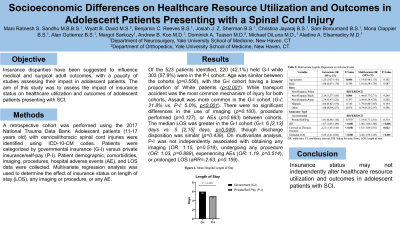Socioeconomic Differences on Healthcare Resource Utilization and Outcomes in Adolescent Patients Presenting with a Spinal Cord Injury
Friday, April 21, 2023


Aladine A. Elsamadicy, MD
Resident Physician
Yale School of Medicine
New Haven, Connecticut, United States
ePoster Presenter(s)
Introduction: Insurance disparities have been suggested to influence medical and surgical adult outcomes, with a paucity of studies assessing their impact in adolescent patients. The aim of this study was to assess the impact of insurance status on healthcare utilization and outcomes of adolescent patients presenting with SCI.
Methods: A retrospective cohort was performed using the 2017 National Trauma Data Bank. Adolescent patients (11-17 years old) with cervical/thoracic spinal cord injuries were identified using ICD-10-CM codes. Patients were categorized by governmental insurance (G-I) versus private insurance/self-pay (P-I). Patient demographic, comorbidities, imaging, procedures, hospital adverse events (AE), and LOS data were collected. Multivariate regression analysis was used to determine the effect of insurance status on length of stay (LOS), any imaging or procedure, or any AE.
Results: Of the 523 patients identified, 220 (42.1%) held G-I while 303 (57.9%) were in the P-I cohort. Age was similar between the cohorts (p=0.556), with the G-I cohort having a lower proportion of White patients (p < 0.001). While transport accident was the most common mechanism of injury for both cohorts, Assault was more common in the G-I cohort (G-I: 21.8% vs. P-I: 5.0%, p< 0.001). There were no significant differences in the use of imaging (p=0.100), procedure performed (p=0.127), or AEs (p=0.663) between cohorts. The median LOS was greater in the G-I cohort (G-I: 6 [2,13] days vs. 5 [2,15] days, p=0.049), though discharge disposition was similar (p=0.439). On multivariate analysis, P-I was not independently associated with obtaining any imaging (OR: 1.15, p=0.519), undergoing any procedure (OR: 1.03, p=0.889), experiencing AEs (OR: 1.19, p=0.514), or prolonged LOS (aRR=-2.63, p=0.159).
Conclusion : Insurance status may not independently alter healthcare resource utilization and outcomes in adolescent patients with SCI. Knowledge of treatment outcomes of patients from varying socioeconomic backgrounds is necessary to ensure equitable care of adolescent SCI patients.
Methods: A retrospective cohort was performed using the 2017 National Trauma Data Bank. Adolescent patients (11-17 years old) with cervical/thoracic spinal cord injuries were identified using ICD-10-CM codes. Patients were categorized by governmental insurance (G-I) versus private insurance/self-pay (P-I). Patient demographic, comorbidities, imaging, procedures, hospital adverse events (AE), and LOS data were collected. Multivariate regression analysis was used to determine the effect of insurance status on length of stay (LOS), any imaging or procedure, or any AE.
Results: Of the 523 patients identified, 220 (42.1%) held G-I while 303 (57.9%) were in the P-I cohort. Age was similar between the cohorts (p=0.556), with the G-I cohort having a lower proportion of White patients (p < 0.001). While transport accident was the most common mechanism of injury for both cohorts, Assault was more common in the G-I cohort (G-I: 21.8% vs. P-I: 5.0%, p< 0.001). There were no significant differences in the use of imaging (p=0.100), procedure performed (p=0.127), or AEs (p=0.663) between cohorts. The median LOS was greater in the G-I cohort (G-I: 6 [2,13] days vs. 5 [2,15] days, p=0.049), though discharge disposition was similar (p=0.439). On multivariate analysis, P-I was not independently associated with obtaining any imaging (OR: 1.15, p=0.519), undergoing any procedure (OR: 1.03, p=0.889), experiencing AEs (OR: 1.19, p=0.514), or prolonged LOS (aRR=-2.63, p=0.159).
Conclusion : Insurance status may not independently alter healthcare resource utilization and outcomes in adolescent patients with SCI. Knowledge of treatment outcomes of patients from varying socioeconomic backgrounds is necessary to ensure equitable care of adolescent SCI patients.
